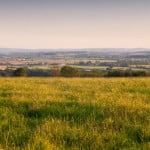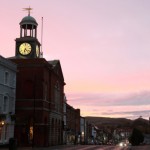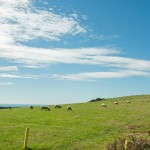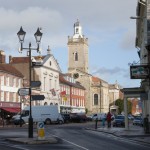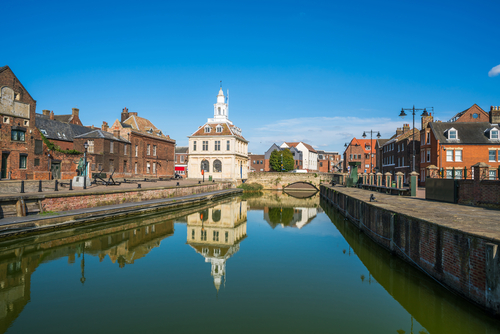
King’s Lynn is a seaport and market town in Norfolk, East Anglia, England about 98 miles (158 km) north of London, and 44 miles (71 km) west of Norwich. The town stands on the banks of the River Ouse. The town is and has for generations been simply known as ‘Lynn’ by its residents. The current population of King’s Lynn (2020), within the town boundaries, is approximately 44,000.
A Fleeting Kings Lynn History
King’s Lynn was originally known simply as ‘Lynn’, which is the Celtic word for lake or pool. It’s thought that a large tidal lake once covered the King’s Lynn area. In the Domesday Book, it’s referred to as; Lun or Lenn, and was deemed as being owned by the Bishop of Elmham and the Archbishop of Canterbury.
In 1101, Herbert de Losinga, Bishop of Thetford (and later Norwich), commissioned the building of St. Margaret’s Church (now King’s Lynn Minster) in Lynn. He also granted the town a weekly market and an annual fair. A small prosperous settlement quickly grew around the church.
In 1204, Bishop John de Grey of Norwich granted the town a charter, prompting its name to be duly changed to Bishop’s Lynn. The town quickly expanded to its established northern and southern boundaries of Purfleet and Millfleet, ‘fleet’ being an Old English word for stream. By the start of the 13th century, the town had embarked on better planning, as new streets became wider and the market areas enlarged.
By the 14th century, King’s Lynn had a population of some 5,000-6,000, a sizable town by the standards of the day. Salt, wool and grain were the chief exports, while timber and iron were the major imports. Fishing was also a major industry.
During the 15th century, Bishop’s Lynn continued to grow wealthy on both domestic and overseas trade. It greatly benefitted from its association with the Hanseatic League, a powerful medieval North European trading organisation made up of merchants from North Germany and its Baltic neighbours. The town still retains two former Hanseatic League buildings; Hanse House and Marriott’s Warehouse, which date from the 15th and 16th century. These are the only buildings from the days of the Hanseatic League, dissolved in the 17th century, left still standing in Britain.
After the dissolution of the monasteries by Henry VIII in 1537, Bishop’s Lynn changed its name to Lynn Regis, from which its current name of King’s Lynn is derived.
The Civil War
In 1642, at the outbreak of the English Civil War, King’s Lynn supported Parliament, but the town changed sides a year later. Parliament duly sent an army, and put the town under siege for three weeks, before they surrendered. Also in the 17th century, King’s Lynn’s port suffered from the discovery of the Americas, with favour being transferred to the ports on the west coast of England. Trade was also affected by the growth of London. Although no longer a major international port, grain was still being exported, while iron and timber were being imported.
By the mid–17th century, draining of the Fens was underway with the land being turned over to agriculture. It wasn’t long before large amounts of fresh produce were being sent to the growing London markets. In the late 17th century, imports of wine from Spain, Portugal and France boomed. There was still also important coastal trade, which was mainly in the form of coal arriving from the northeast of England. In 1683, Custom House was commissioned by Sir John Turner and designed by architect Henry Bell. It was a merchants’ exchange and a place to regulate trade through the port.
By the late 17th century, while fishing was still important to the town, the new industries of glassmaking and shipbuilding, as well as the associated industries of sail-making and rope-making, were also thriving. Consequently, the population continued to grow. By 1801, the population of Kings Lynn was around 10,000, which by 1851, had risen to some 20,000. However, after that, the population initially fell back a little and then grew slowly during the second half of the 19th century.
King’s Lynn continued to see some improvements to the town. Acts of Parliament introduced during the early part of the 19th century, saw street paving, cleaning and lighting, made compulsory, although such laws proved difficult to implement. In 1835, the Lynn and West Norfolk hospital opened, and by the late 19th, the town had sewers and relatively clean water supply. The railway reached the town in 1847. The Corn Exchange was built in 1854, the public baths in 1856, and the County Court in 1861. Kings Lynn’s port facilities also continued to expand, with Alexandra Dock being opened in 1869, and Bentinck Dock in 1883. And, while glassmaking ended in King’s Lynn in the late 19th century, brand new industries such as the manufacture of farm machinery and mechanical excavators, grew.
Amenities in Kings Lynn continued to improve during the start of 20th century, as a museum opened in 1904, a public library in 1905, and a cinema in 1928.
During WW I, King’s Lynn was one of the first towns in Britain to experience aerial bombing. On 19 January 1915, a German Zeppelin airship dropped 11 bombs that caused extensive damage, killing 2 people and injuring several others. In the 1930s, like much of the rest of the country, the local authority began a programme of slum clearance and regeneration.
In WW II, it was assumed that King’s Lynn would be safe from German bombing, subsequently, many evacuees arrived from London. However, King’s Lynn suffered almost 100 bombing raids during the 5-year conflict. The worst was in June 1942, at the site of the Eagle Hotel in Norfolk Street, which killed 42 people. The bombing of the town prompted some of the evacuees to return home.
Modern King’s Lynn
In the 1960s, redevelopment of the town centre began. New housing estates were built at the Woottons and Gaywood, and an industrial estate at Hardwick. New industries arrived, including light engineering, textiles and chemicals. The Vancouver Shopping Centre was also built during the 1960s.
The Lynnsport sports centre was opened in 1982. In 1996, the former Corn Exchange building was converted into a theatre.
In 2004, work got underway to regenerate the entire city centre through a multi-million-pound scheme. As part of this, the Vancouver Shopping Centre, renamed the Vancouver Quarter, has been completely refurbished. The scheme is still ‘a work in progress’ and there are now plans for a multi-million-pound project to similarly regenerate King’s Lynn’s waterfront.
In 2006, King’s Lynn became the United Kingdom’s first member of The Hanse (Die Hanse), a network of towns and cities across Europe which historically belonged to the Hanseatic League.
Today, King’s Lynn has managed to retain a good many of its historic buildings, cobbled streets and courtyards. An important medieval town and port, King’s Lynn’s maritime past is still evident throughout the town. Custom House overlooking the original medieval harbour.
Getting To King’s Lynn
By Road
King’s Lynn is at the end of the A10 from London and Cambridge. The A17 runs southwest from Newark to King’s Lynn. The town also lies on A47 between Birmingham and Great Yarmouth.
By Train
There are direct trains from London King’s Cross via Cambridge and Ely which terminate at King’s Lynn. There are also direct trains from London’s Liverpool Street. The overall journey time on both routes is around 2 hours. It’s a 5-minute walk from the train station to the town centre. If you are travelling from the North or the Midlands then you can get to King’s Lynn via Birmingham.
By Bus
National Express runs a service from London Victoria Coach Station to Peterborough where you will need to change buses for King’s Lynn. Travelling from the North you will probably need to change buses at Birmingham.
By Air
The nearest airport to King’s Lynn is Norwich, which is 38 miles away. The nearest major international airports are London Stansted (STN) (60 miles) and London Luton (LTN) (69 miles).
Getting around!
The majority of bus services in and around King’s Lynn are operated by Stagecoach. It also operates the ‘Coasthopper’ service, around the North Norfolk coast.
Other services in and around King’s Lynn are operated by Lynx Bus and First. The latter also operates longer distance services to nearby towns such as Peterborough, Lowestoft, Wisbech, Norwich and Great Yarmouth.
A Local Hero
Deemed King’s Lynn’s most famous son, but conversely, could be said to be one of Britain’s great unsung heroes, is the explorer and navigator Captain George Vancouver (1758-1798). He certainly doesn’t share the same prominence as other great British naval adventurers, such as Drake, Raleigh, Cook or Nelson.
Born in King’s Lynn on 22 June 1757, George Vancouver was the sixth and youngest child of John Jasper Vancouver, a Dutch immigrant, and Bridget Berners. At the age of 13, he began his naval career as an able seaman under Captain James Cook on board the Resolution. By 1780, Vancouver had been promoted to lieutenant, served several years in the West Indies, followed up by voyages to Australasia. However, his most famous undertaking was the exploration of the North Pacific coast of North America, largely in search of the fabled Northwest Passage.
In April 1792, Vancouver’s ship; Discovery, saw off a cabal of American ships to reach the northwest American coast first, and declare the land as ‘British Columbia’. He and his men painstakingly charted the region’s challenging coastline, using Norfolk designations for many of the newly named places. Today, part of the Canadian of the province of British Columbia still bears his name, i.e. Vancouver Island and the coastal seaport of Vancouver.
Vancouver returned to England in 1795 and began to prepare his journals. Tragically, he died of unknown causes at Petersham on May 10, 1798, before managing to complete them. His brother finished off the writings and published the works within a few months of Vancouver’s death.
Quirky King’s Lynn
- Of all the places in the world, it was in King’s Lynn that ‘Campbell’s’ soup makers, decided to build their very first factory outside of the USA. The factory opened in 1959 and closed in 2007.
- According to the Lynn News, of all the lawnmowers that are stolen in Norfolk, almost 50% go missing in and around King’s Lynn.
- A recent survey found that 14% of King’s Lynn workforce travel to work by bike, compared to the national average of just 2%.
- Some 5.9% of all households in the King’s Lynn area are caravans or other similar types of temporary home, compared with the countrywide average of just 0.4%.
Things to see and do!
Just some of the recommended things to see and do around King’s Lynn are:
- King’s Lynn Minster – founded in 1101 it was formerly St Margaret’s Church, was. It has impressive stained glass windows and an attractive garden.
- Hanse House – Grade I listed, dating back to 1485, it’s one of only two and largely original surviving Hanseatic warehouses in England.
- Marriott’s Warehouse – 16th century restored building, houses a café and restaurant and has old town scale models (1st floor).
- Custom House – Built in 1683, it was used as a customs house until the early 1700s. Inside tells local maritime tales, including those of Nelson, Vancouver and smugglers.
- George Vancouver Statue – situated outside of Custom House, sculpture to local hero; Captain George Vancouver.
- Sandringham House – The Queen’s house in Norfolk, privately owned by the royal family since 1862, lies 6 miles north-east of King’s Lynn. The house is open mid-April to October and the magnificent gardens, all year round. There’s also a museum and a church in the grounds.
- Lynn Museum – displays local history, including Seahenge a wooden structure from 2049 BC. Opens Tue-Sat; 10:00 – 17:00.
- Castle Rising – well-preserved castle dating back to 1140.
- Castle Arce Priory – deemed one of the largest and best-preserved monastic sites in England. It dates back to 1090, the grounds are abundantly populated by owls, squirrels and rabbits.
Where to stay?
There’s accommodation in Kings Lynn to suit most tastes and budgets. A broad indication of prices for commonly available accommodation in the area is:
B & B/Guesthouses/Standard Hotels: £50 – £80
3/4/5 Star Hotels: £80 – £200
Holiday Home/Apartments: £300 – £400 (4 – 6 adults sharing)

